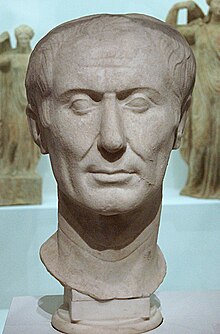art.wikisort.org - Escultura
El Busto Tusculum, también llamado el Retrato Tusculum, es el único retrato que Julio César se hizo en vida.[1] Es también una de las dos representaciones fidedignas aceptadas de César (junto al César de Chiaramonti) que se hicieron antes del principio del Imperio Romano.[2] Siendo una de las copias del original de bronce, el busto está datado en los años 50 a 40 A.C. y está albergado en la colección permanente del Museo de Antigüedades de Turín, Italia.[3][4] Hecho de mármol de grado fino, el busto mide 33 cm de altura.

Descripción
Las características faciales del retrato son compatibles con los empleados en las monedas representando a César que se acuñaron en su último año de vida, particularmente en el denario emitió por Marcus Mettius.[3] La cabeza del busto está prolongada, debido a una deformación causada por la osificación prematura de las suturas entre los huesos parietal y temporal que César tuvo de niño.[2] El retrato también exhibe un elevado índice cefálico.
Historia
El busto fue excavado por Luciano Bonaparte en el foro de Tusculum en 1825 y posteriormente llevado al Castillo de Agliè, aunque no fue reconocido como un busto de César hasta que Maurizio Borda lo identificó en 1940. El retrato fue exhibido en el Museo del Louvre junto al busto de Arles, hasta que fue trasladado al Museo de Antigüedades de Turín. Hay tres copias conocidas del busto, una en la Abadía de Woburn y otras en colecciones privadas en Florencia y Roma.[4][5]
Véase también
- Busto de Arles, tercer posible retrato fidedigno de Julio César.
Referencias
- Tom Stevenson (2014). Julius Caesar and the Transformation of the Roman Republic. Routledge. ISBN 978-1317597537.
- The J. Paul Getty Museum (1987). Ancient Portraits in the J. Paul Getty Museum: Volume 1. Getty Publications. p. 27. ISBN 0892360712.
- Miriam Griffin, ed. (2009). A Companion to Julius Caesar. John Wiley & Sons. p. 302. ISBN 978-1444308457.
- Sparavigna, Amelia Carolina (21 de junio de 2012). «Portraits of Julius Caesar: a proposal for 3D analysis». arXiv:1206.4866 [cs]. Consultado el 12 de abril de 2021.
- Griffin, Miriam T. (2009). A companion to Julius Caesar. Wiley-Blackwell. ISBN 978-1-4443-0845-7. OCLC 429074904. Consultado el 12 de abril de 2021.
На других языках
[en] Tusculum portrait
The Tusculum portrait, also called the Tusculum bust, is the only extant portrait identified as Julius Caesar which may have been made during his lifetime.[1] It is also one of the two accepted portraits of Caesar (alongside the Chiaramonti Caesar) which were made before the beginning of the Roman Empire.[2] Being one of the copies of the bronze original,[3] the bust has been dated to 50–40 BC and is housed in the permanent collection of the Museo d'Antichità in Turin, Italy.[4] Made of fine-grained marble, the bust measures 33 cm (1ft 1in) in height.- [es] Busto Tusculum
Другой контент может иметь иную лицензию. Перед использованием материалов сайта WikiSort.org внимательно изучите правила лицензирования конкретных элементов наполнения сайта.
WikiSort.org - проект по пересортировке и дополнению контента Википедии